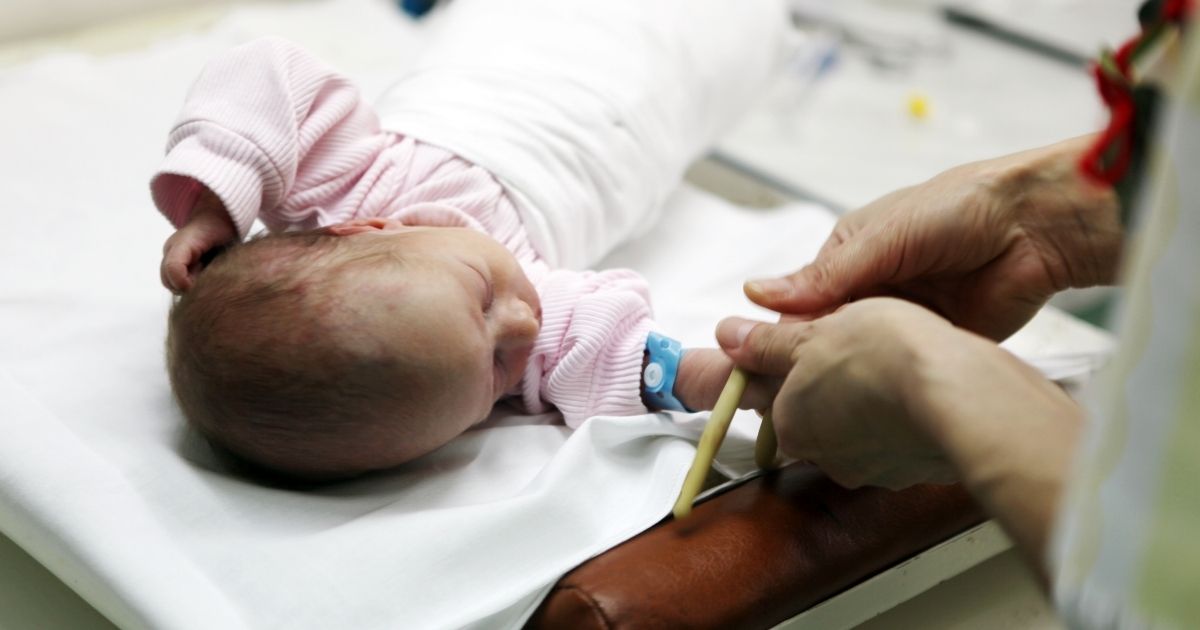
Authors: Jamie Klein; Kathryn Elkins, MD, Emory University School of Medicine;
Stephanie R. Keller, MD, Children’s Healthcare of Atlanta
Reviewed: August 2021
SUMMARY
Krabbe disease (KD) is a rare disorder that affects the brain, spinal cord, and nerves. Children with this disease are missing an important enzyme called galactocerebrosidase. This enzyme breaks down toxic chemicals in the body. Without it, toxic chemicals build up. This buildup can lead to the destruction of myelin, the protective layer around the nerve cells in the body and brain. Without this protective layer, nerves do not work properly, and the brain is injured.
KD is a member of a group of genetic diseases called leukodystrophies. Diseases in this group involve problems with the white matter—the myelin—of the brain. KD is also known as globoid cell leukodystrophy.
KD usually first appears in infants younger than one year of age. In these cases, common symptoms include:
- Fussiness and irritability
- Weak muscles
- Stiffness
- Loss of smiling or normal interaction
The disease can rapidly worsen. It can lead to:
- Difficulty feeding
- Vision loss
- Seizures
- Loss of developmental milestones
Less commonly, KD can first appear later in childhood, adolescence, or adulthood. When KD first begins after the first year of life, the disease may progress more slowly. Early symptoms in these cases may include:
- Vision problems
- Weakness
- Difficulty walking
JUMP TO
Disorder Overview
DESCRIPTION
Children with KD develop normally in their first months of life. During these first months, they meet developmental milestones including smiling, holding their heads up, and cooing.
However, children with infantile KD will eventually start to lose their milestones. For example, a baby who once smiled may stop smiling. As more nerve cells become injured, children have difficulty with more activities, including:
- Eating
- Seeing
- Moving
- Breathing
KD can present in infancy, childhood, adolescence, or adulthood. In infantile KD, symptoms begin when the child is younger than one year of age. This form of KD is the most common and most severe. Symptoms may quickly worsen without treatment. Children with infantile KD typically pass away by age 2 or 3 years of age.
In KD that appears after one year of age, children usually live longer, and the disease is slower to progress.

SIGNS AND SYMPTOMS
Common Symptoms
Common symptoms of KD include:
- Fussiness and irritability
- Muscle weakness
- Difficulty eating or drinking
- Difficulty holding the head up
- Holding hands in fists
- Stiff muscles
- Loss of milestones (for example, a child may stop smiling, sitting, reaching, or crawling)
- Seizures
- Unexplained fever
Some symptoms of KD can be mistaken for other issues. For instance, irritability and back arching are often present in babies with infantile KD. These symptoms can be mistaken for signs of colic or reflux.
CAUSES
Krabbe disease is a genetic disorder. It occurs when a child receives two abnormal genes from parents. One abnormal gene must come from each parent. The gene involved in this disease is called the GALC gene.
Parents are considered “carriers” if they have one abnormal copy of the GALC gene and one normal copy. Carriers do not have symptoms of KD. A carrier parent has a 50% chance of passing on their abnormal copy of the GALC gene. If both parents are carriers of KD, and both parents pass on the abnormal copy, a child will have KD. There is a 25% chance that two carrier parents together will have a child with KD.
LABORATORY INVESTIGATIONS
Diagnosis
Some states test for KD as a part of newborn screening. A doctor may also suspect a child has Krabbe disease if the child has typical symptoms of the disease, including fussiness, loss of developmental milestones, and muscle weakness or stiffness.
However, KD is diagnosed with the use of multiple tests. These include:
Blood testing
Nerve conduction studies
Brain imaging
Pictures of the brain taken with magnetic resonance image (MRI) or a computerized tomography scan (CT scan). An MRI of the brain may be the first test to show signs of KD. An MRI scan of the brain is the far superior test for checking the white matter, as it is much more sensitive in detecting changes.
Lumbar punctures

TREATMENT AND THERAPIES
Stem-Cell Transplantation
Currently, there is no cure for Krabbe disease. Children diagnosed before they have significant symptoms may be eligible for a stem-cell transplant, which can help slow the progression of the disease. For early infantile KD patients, a stem-cell transplant is most helpful when done within the first 30 days of life. Unfortunately, a transplant cannot repair damage already done by the disease.
Gene Therapy
Research on gene therapy for KD is ongoing. Gene therapy for KD would replace abnormal GALC gene copies for normal copies. This type of treatment is not available yet.
Treatment of Symptoms
There are treatments available to help with a child’s irritability, muscle stiffness, pain, seizures, and difficulty eating. These treatments include:
- Medications for irritability and pain, such as gabapentin
- Medications to help muscles relax, such as baclofen
- Physical therapy to help with movement and flexibility
- Antiseizure medications
- Feeding tubes to help with eating and drinking

OUTLOOK
KD usually presents before age 6 months, and death occurs by age 2. Although stem-cell transplants slow down the worsening of the disease, children who receive this treatment may still develop difficulty with speech, walking, and learning. Stem cell transplants are not recommended in children with significant symptoms. In these cases, the transplants are not helpful at slowing the disease.
Unfortunately, treatments that address symptoms do not change the prognosis. Still, medications, physical therapy, and feeding support can help children feel more comfortable. Children with KD often have more breathing problems later in the disease and require home oxygen or other interventions. Medical equipment or bracing may help maintain movement of joints and help with the transportation and care of the child at home. It is helpful for caregivers to have the additional support of friends or family members when caring for the child.
Insurance companies may provide some nursing care at home. For some families, hospice care may be appropriate during end-of-life care.
RELATED DISORDERS
KD is part of a group of diseases called leukodystrophies. Other leukodystrophies include:
- Metachromatic leukodystrophy
- X-linked adrenoleukodystrophy
KD is also part of a group of metabolic diseases called lysosomal storage disorders.
Resources
United Leukodystrophy Foundation
The United Leukodystrophy Foundation (ULF) is a volunteer-based health organization dedicated to providing patients and their families with information about Krabbe disease and other leukodystrophies. The ULF provides assistance in identifying sources of medical care, social services, and genetic counseling. In addition, the ULF works to establish a communication network among families; as well as increases public awareness and acts as an information source for health care providers by promoting and supporting research into causes, treatments, and prevention of the leukodystrophies.
KrabbeConnect
KrabbeConnect’s mission is to be the source of comprehensive information and access to resources for patients with Krabbe disease. The foundation bridges the gap between science and patient knowledge by maintaining a long-term engagement study on patients with Krabbe disease. KrabbeConnect also has a robust patient assistance program that includes a Treatment and Resource Maps page. For educational webinars on important topics to help families feel well informed about Krabbe disease, visit the Listen and Learn webinar page.
Hunter’s Hope
Hunter’s Hope Foundation was established to address the acute need for information and research with respect to Krabbe disease and other related leukodystrophies.
The mission is four-fold:
- To broaden public awareness of Krabbe disease and other leukodystrophies thus increasing the probability of early detection and treatment.
- To gather and provide current, functional information and service linkages to families of children with leukodystrophies.
- To fund research efforts that will identify new treatments, therapies and ultimately, a cure for Krabbe disease and other leukodystrophies.
- To establish an alliance of hope that will nourish, affirm and confront the urgent need for medical, financial and emotional support of family members and those afflicted with leukodystrophies.

Child Neurology Foundation (CNF) solicits resources from the community to be included on this webpage through an application process. CNF reserves the right to remove entities at any time if information is deemed inappropriate or inconsistent with the mission, vision, and values of CNF.
Research
ClinicalTrials.gov for Krabbe Disease are clinical trials that are recruiting or will be recruiting. Updates are made daily, so you are encouraged to check back frequently.
ClinicalTrials.gov is a database of privately and publicly funded clinical studies conducted around the world. This is a resource provided by the U.S. National Library of Medicine (NLM), which is an institute within the National Institutes of Health (NIH). Listing a study does not mean it has been evaluated by the U.S. Federal Government. Please read the NLM disclaimer for details.
Before participating in a study, you are encouraged to talk to your health care provider and learn about the risks and potential benefits.
Family Stories
The United Leukodystrophy Foundation shares stories to raise awareness and to let families connect and know they are not alone after a diagnosis of leukodystrophy. See the Not Giving Up page to read about others and share your story.
Families affected by leukodystrophies share how the Leukodystrophy Care Network has impacted their lives. Leukodystrophy Family Stories of Hope can be found on the Hunter’s Hope website.
Stories, interviews, and a tribute to patients with Krabbe disease can be found on the KrabbeConnect YouTube page.
The information in the CNF Child Neurology Disorder Directory is not intended to provide diagnosis, treatment, or medical advice and should not be considered a substitute for advice from a healthcare professional. Content provided is for informational purposes only. CNF is not responsible for actions taken based on the information included on this webpage. Please consult with a physician or other healthcare professional regarding any medical or health related diagnosis or treatment options.
References
Escolar ML, West T, Dallavecchia A, Poe MD, LaPoint K. Clinical management of Krabbe disease. J Neurosci Res. 2016 Nov;94(11):1118-25. PMID: 27638597; https://doi.org/10.1002/jnr.23891
https://www.mayoclinic.org/diseases-conditions/krabbe-disease/diagnosis-treatment/drc-20374183
https://medlineplus.gov/genetics/condition/krabbe-disease/
Kwon JM, Matern D, Kurtzberg J, Wrabetz L, Gelb MH, Wenger DA, Ficicioglu C, Waldman AT, Burton BK, Hopkins PV, Orsini JJ. Consensus guidelines for newborn screening, diagnosis and treatment of infantile Krabbe disease. Orphanet J Rare Dis. 2018 Feb 1;13(1):30. PMID: 29391017; https://doi.org/10.1186/s13023-018-0766-x
I am text block. Click edit button to change this text. Lorem ipsum dolor sit amet, consectetur adipiscing elit. Ut elit tellus, luctus nec ullamcorper mattis, pulvinar dapibus leo.
